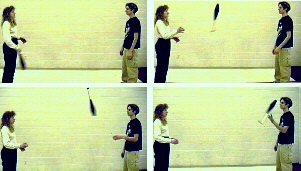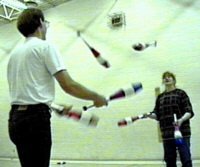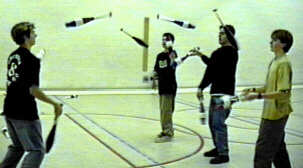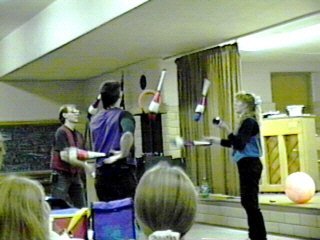Throwing Passes

Passing props with another juggler is a lot of fun, and has even been described as addictive. There's an amazing sensation when a 3 club juggler learns to pass 6 clubs with a partner. The flurry of clubs flipping around seems to be more than the brain should be able to follow, yet a club always manages to arrive when and where a hand reaches for one. Well, most of the time anyway. Just as a solo juggler makes quick subconscious adjustments to the pattern, reaching over for a throw that went a little wide or grabbing a club a little early if it's overspun, a passing juggler makes a multitude of tiny adjustments to the nuances of his or her partners juggling. Before long, passers find the whole pattern seems to take care of itself, freeing them to explore a new world of tricks. Besides all the body throws like under-the-leg and behind-the-back, passing tricks include countless ways to break and repair the timing of the pattern.
More than likely, you've seen jugglers pass and it looked like fun, and now you want to try it. Great. Let's get started.
First, find a partner. You need a juggler who can easily juggle 3 of whatever prop you want to pass. Get six of those props, hopefully fairly well matched. Obviously, they're going to get mixed together.

You and your partner can each practice this step alone if you like. Juggle a cascade, counting each right hand throw. On the count of four, throw that prop from your right hand, straight out away from you. Imagine your partner standing about eight feet in front of you, facing you. Aim for your partner's LEFT shoulder, and make the throw peak at the same height as any other throw in the pattern. Since you're in the habit of throwing to your left hand and now you're trying to throw 90 degrees to the right of that, you may find your passes tend to go to the left of your target at first. Practice until you can throw a pass straight out in front of your right hand.
If you're using clubs, try a few passes with your partner using only one club. Make a point to dip the club down by your leg before you pass it. Catch the club when the it is vertical, with the handle pointing down.
Hold a prop in each hand, and have your partner throw a third to your left hand, with a normal throw just like you've been practicing. As it peaks on it's way to your hand, make a throw from your left hand towards your right, then catch the pass and continue juggling.
Catching a prop into a juggling pattern will take a few tries at first, but very soon it will seem natural. A good way to practice this is to start with 3 props while your partner starts with 2. Juggle 3 until your fourth right hand throw, and pass that one to your partners left hand. Your partner should catch the pass, juggle for 4 throws and pass one back to you. Go back and forth for a while and it will quickly get easy.
Stand facing your partner, each of you holding 2 props in the right hand and 1 in the left. Raise your right hand, wait for your partner to do the same, and together bring your right hands down to your side and back up, making the first throw. One or both of you should count out loud at first, counting right hand throws. Try to adjust to each others pace. If you're falling behind, making lower throws. If you're getting ahead, raise the pattern. Find a tempo that's comfortable for both of you and juggle together at that pace for a minute or two to get used to juggling to a beat.

Face your partner, each holding 2 props in the right hand, start together and juggle in synch. Count right hand throws and pass the fourth one. Start the counting with "one" again on the next right hand throw, and keep going, passing each time you get to "four". Congratulations! You're passing 8 count. That is, you're passing every 8th throw (counting both hands.) Practice that until you get the hang of it. When you want to stop, call out "hup", "finish" or some other signal to your partner as you throw a pass, then collect your props.
Now pick up the pace. In stead of passing every fourth right hand throw, move up to every third, which is 6 count passing. Then move on to 4 count, "every others". This is probably the most popular passing count. Work up to 2 count ("everies"), passing every right hand throw. For an additional challenge, try left handed passing. Once you can pass with both hands, try 3 count. You can even work your way up to 1 count, passing every single throw.
Throwing a few "self" throws before beginning to pass is called a "slow start". For a "fast start", pass on the first throw.

Get together some other jugglers who can pass, and try passing as a group. Pick a group pattern and a passing count, and pick one juggler whom the rest call all see, and watch that juggler to start the pattern so everyone is in synch.
One of the most common ways to pass with a group is in a "feed". One person passes with each of the others in turn, like in the picture above. We'll add to this section soon, showing a variety of ways a group can pass.
When you drop a prop while passing, you don't have to stop the whole pattern. If the prop lands closer to you than your partner, it's your job to pick it up. If you have three props and your partner has two, keeping passing at the regular pace, but your partner should skip one pass. That will give your partner three props and leave you with two. At that point it's not too difficult to pick up the dropped prop and pass it.
Pickups in patterns faster than 4 count can be a little trickier. A common method is called "running the gap." Whether you have two or three props, keep juggling the cascade and passing on the beat, pretending the sixth prop is still in the pattern. It helps to make the throwing and catching motions as the gap (the spot where the sixth prop would normally be) moves through your pattern. You can pass the gap just like you would pass a prop. Practice that for a while, passing 5 but pretending to have 6. When you and your partner can do this comfortably, it's just a matter of crouching down by the dropped prop while you run the gap, and picking it up when the gap gets to the hand closest to the it.
When you're passing with a juggler who's in the habit of doing pickups without stopping the pattern, pay attention when a prop is dropped. If you quickly stop juggling and bend down to pick up a prop, you may get hit with an incoming pass. To put it simply, never assume your partner will stop passing the moment you do.

Try some body throws, like passing under your leg, behind your back (watch out for your partner's pass), etc. You can do many tricks on throws to yourself in addition to passes. With clubs, try "floaters" or "flats" (throws with no flip) or reverse flips. "Chops" or "tomohawks", downward throws from up by your shoulder, look great but take some practice to make them easy for your partner to catch. A more difficult trick is the shoulder throw, swinging a club back behind you and releasing it as it loops forward over your shoulder. You can also do siteswap tricks, like the 4413 or 5313 while passing.
There are also a wide range of timing tricks to try. A good one to start with is an early double. When passing 4 count, catch a pass from your partner in your left hand, and in stead of throwing that prop to yourself, pass it right back to your partner. Throw it a little more than twice the usual height, going to your partners left hand. With clubs this throw is usually done with a double flip, hence the name. You get to skip a beat, holding a club in each hand while you wait for your partners next pass. If it's thrown correctly, the pass arrives at your partners hand at the same time and position as a normal pass. The next step is an early triple. When you would normally throw a right-to-left self in every-others, throw a pass four times the normal height to your partner. You skip two beats and your partner just keeps juggling, catching the prop like any other pass, except that it's coming from up in the clouds. Another timing trick to try is the late double. Throw it at the same time you would normally throw a pass, but throw it twice as high and to your partners RIGHT hand. This makes your partner skip a beat, not you.
Timing tricks work in other counts too, but they often need some adjustment. For instance, to throw an early triple while passing 2 count, you would need to throw a regular pass and the early triple from the same hand at the same time. To get around this, throw your partner an early double first. It's a neat combination, since you actually throw 3 passes on 3 consecutive beats- a normal pass, an early double, then the early triple, while your partner keeps passing at a steady 2 count.
The Coulee Region Jugglers and Unicyclists (crju@jugglingpoet.com) 5/02